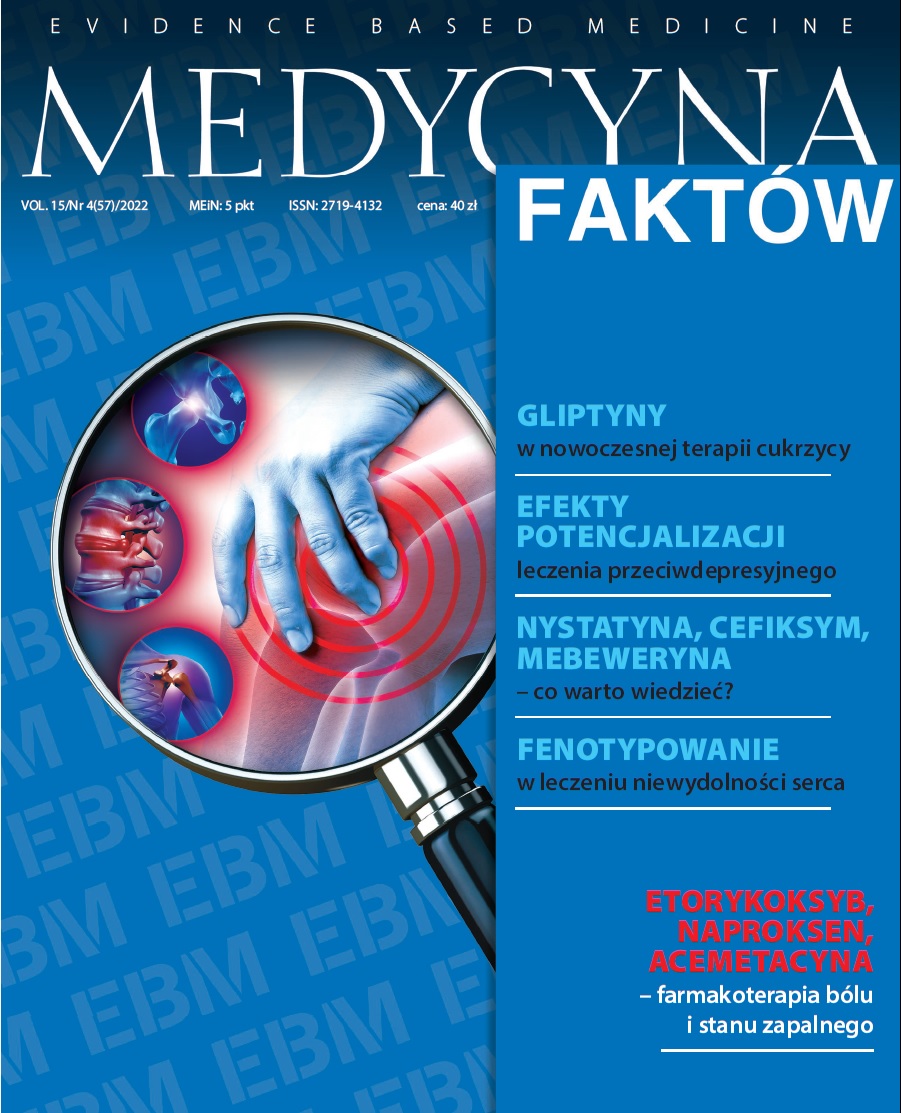Zastosowanie citalopramu w praktyce klinicznej Opis przypadku
##plugins.themes.bootstrap3.article.main##
Abstrakt
Citalopram to lek znany od ponad 30 lat, obecnie często stosowany jako uzupełnienie przy braku satysfakcjonującej odpowiedzi na monoterapię. Lek ma niewielki potencjał do wchodzenia w interakcje międzylekowe. Jest skuteczny i dobrze tolerowany w zapobieganiu nawrotom depresji u osób starszych.
##plugins.themes.bootstrap3.article.details##
Jak cytować
Smolarczyk-Kosowska, J., & Pudlo, R. (2022). Zastosowanie citalopramu w praktyce klinicznej . Medycyna Faktów , 15(4(57), 444-448. https://doi.org/10.24292/01.MF.0422.12
Numer
Dział
Artykuły
Copyright © by Medical Education. All rights reserved.
Bibliografia
1. Stahl SM. Prescriber’s Guide. 6th ed. Cambridge University Press 2017.
2. Charakterystyka produktu leczniczego: Cipramil (6.11.2020).
3. DeVane CL. Pharmacokinetics of the selective serotonin reuptake inhibitors. J Clin Psychiatry. 1992; 53: 13-20.
4. Muldoon C. The safety and tolerability of citalopram. Int Clin Psychopharmacol. 1996; 11(suppl 1): 35-40. http://doi.org/10.1097/00004850-199603001-00007. Erratum in: Int Clin Psychopharmacol. 1996; 11(2): 153.
5. Bazire S. Przewodnik leków psychotropowych. Via Medica, Gdańsk 2018.
6. Edinoff AN, Akuly HA, Hanna TA et al. Selective Serotonin Reuptake Inhibitors and Adverse Effects: A Narrative Review. Neurol Internat. 2021; 13(3): 387-401. http://doi.org/10.3390/neurolint13030038.
7. Siwek M. Dekalog leczenia depresji. ITEM Publishing, Warszawa 2021.
8. David DJ, Gourion D. Antidépresseurs et tolérance: déterminants et prise en charge des principaux effets indésirables [Antidepressant and tolerance: Determinants and management of major side effects]. Encephale. 2016; 42(6): 553-61. http://doi.org/10.1016/j.encep.2016.05.006.
9. Bech P, Tanghøj P, Andersen HF et al. Citalopram dose-response revisited using an alternative psychometric approach to evaluate clinical effects of four fixed citalopram doses compared to placebo in patients with major depression. Psychopharmacology (Berl). 2002; 163(1): 20-5. http://doi.org/10.1007/s00213-002-1147-6.
10. Nachimuthu S, Assar MD, Schussler JM. Drug-induced QT interval prolongation: Mechanisms and clinical management. Ther Adv Drug Safety. 2012; 3: 241-53. http://doi.org/10.1177/2042098612454283.
11. Rochester MP, Kane AM, Linnebur SA et al. Evaluating the risk of QTc prolongation associated with antidepressant use in older adults: A review of the evidence. Ther Adv Drug Safety. 2018; 9: 297-308.
12. Kanjanauthai S, Kanluen T, Chareonthaitawee P. Citalopram induced torsade de pointes, a rare life threatening side effect. Int J Cardiol. 2008; 131(1): 33-4. http://doi.org/10.1016/j.ijcard.2007.08.006.
13. U.S. Food & Drug Administration. FDA Drug Safety Communication: Revised Recommendations for Celexa (Citalopram Hydrobromide) Related to a Potential Risk of Abnormal Heart Rhythms with High Doses (access: 20.05.2021).
14. Crépeau-Gendron G, Brown HK, Shorey C et al. Association between citalopram, escitalopram and QTc prolongation in a real-world geriatric setting. J Affect Disord. 2019; 250: 341-5.
15. Klysner R, Bent-Hansen J, Hansen HL et al. Efficacy of citalopram in the prevention of recurrent depression in elderly patients: placebo-controlled study of maintenance therapy. Br J Psychiatry. 2002; 181: 29-35. http://doi.org/10.1192/bjp.181.1.29.
2. Charakterystyka produktu leczniczego: Cipramil (6.11.2020).
3. DeVane CL. Pharmacokinetics of the selective serotonin reuptake inhibitors. J Clin Psychiatry. 1992; 53: 13-20.
4. Muldoon C. The safety and tolerability of citalopram. Int Clin Psychopharmacol. 1996; 11(suppl 1): 35-40. http://doi.org/10.1097/00004850-199603001-00007. Erratum in: Int Clin Psychopharmacol. 1996; 11(2): 153.
5. Bazire S. Przewodnik leków psychotropowych. Via Medica, Gdańsk 2018.
6. Edinoff AN, Akuly HA, Hanna TA et al. Selective Serotonin Reuptake Inhibitors and Adverse Effects: A Narrative Review. Neurol Internat. 2021; 13(3): 387-401. http://doi.org/10.3390/neurolint13030038.
7. Siwek M. Dekalog leczenia depresji. ITEM Publishing, Warszawa 2021.
8. David DJ, Gourion D. Antidépresseurs et tolérance: déterminants et prise en charge des principaux effets indésirables [Antidepressant and tolerance: Determinants and management of major side effects]. Encephale. 2016; 42(6): 553-61. http://doi.org/10.1016/j.encep.2016.05.006.
9. Bech P, Tanghøj P, Andersen HF et al. Citalopram dose-response revisited using an alternative psychometric approach to evaluate clinical effects of four fixed citalopram doses compared to placebo in patients with major depression. Psychopharmacology (Berl). 2002; 163(1): 20-5. http://doi.org/10.1007/s00213-002-1147-6.
10. Nachimuthu S, Assar MD, Schussler JM. Drug-induced QT interval prolongation: Mechanisms and clinical management. Ther Adv Drug Safety. 2012; 3: 241-53. http://doi.org/10.1177/2042098612454283.
11. Rochester MP, Kane AM, Linnebur SA et al. Evaluating the risk of QTc prolongation associated with antidepressant use in older adults: A review of the evidence. Ther Adv Drug Safety. 2018; 9: 297-308.
12. Kanjanauthai S, Kanluen T, Chareonthaitawee P. Citalopram induced torsade de pointes, a rare life threatening side effect. Int J Cardiol. 2008; 131(1): 33-4. http://doi.org/10.1016/j.ijcard.2007.08.006.
13. U.S. Food & Drug Administration. FDA Drug Safety Communication: Revised Recommendations for Celexa (Citalopram Hydrobromide) Related to a Potential Risk of Abnormal Heart Rhythms with High Doses (access: 20.05.2021).
14. Crépeau-Gendron G, Brown HK, Shorey C et al. Association between citalopram, escitalopram and QTc prolongation in a real-world geriatric setting. J Affect Disord. 2019; 250: 341-5.
15. Klysner R, Bent-Hansen J, Hansen HL et al. Efficacy of citalopram in the prevention of recurrent depression in elderly patients: placebo-controlled study of maintenance therapy. Br J Psychiatry. 2002; 181: 29-35. http://doi.org/10.1192/bjp.181.1.29.
